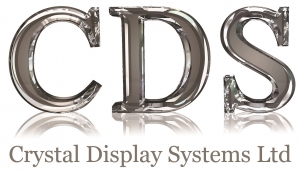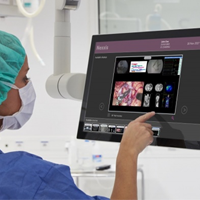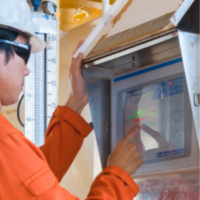Chief editor – Vladimir Krylov, PhD
Deputy chief editor – Michael Nikulichev, PhD
Traditionally we all buy TV sets for our domestic use in specialized stores. TVs differ from monitors. An LCD monitor is either a part of a PC, or a name of the same TV set but only used for commercial or industrial applications. Is there any difference between the two? Informational panels based on TV displays are extremely useful for small and medium business. The advantages are numerous.
The young digital signage market has not settled on universal standards, and potential users of small-scale digital advertising networks have difficult and uninformed decisions to make. This article attempts to convince you why the choice should be made exclusively in favour of commercial LCD monitors, especially in situation when the required application is indoor or semi-indoor (for examples, on public transport stops) advertising network.
Let us clarify that we are not going to discuss the choice of technology. The stable tendency on the market favours LCD technology, especially a LED-backlighting LCD. Plasma slowly but surely disappears from stores. The projection technology remains useful and in demand, but is limited to small number of applications. Therefore, we presume that the decision in favour of LCD screens as advertising indoor carriers was made. The question remains what type of equipment to select.
 |
 |
| Large format full-motion LCD monitor Photo credit: JCDecaux |
Vertical advertising LCD monitor Photo credit: digitalsignageuniverse.com |
Polyfunctionality
Many functions is always good. For a domestic appliance. But not for the commercial equipment, especially for network monitors. Polyfunctionality leads to higher price. But operator of a network is mostly concerned with fast returns on investment. Thus, the number of functions of a commercial monitor must correspond to the tasks it is meant to have. For example, continuous display of advertising clips in a loop that may be interrupted when needed by newsreels or informational inserts.
Excessive parts
Domestic TV sets traditionally have numerous inputs and outputs so that consumers could connect additional equipment and signal sources to their displays. For example, digital output for USB, HDMI/DVI with HDCP option, and analogue: component (BNC)-1, composite (BNC)-1, RGB-1, S-Video. Naturally, there are connectors for audio signal: RGB/DVI Audio-1, composite audio (RCA)-1, composite audio (RCA)-1. Many modern TV sets have in-built network cards and modems for wireless connection that makes these TVs very close to PCs.
For the owner of a small digital network all this means additional expenses for unnecessary parts and functions. Not only this makes equipment more prone to failures but also more vulnerable to hackers who prey on large and small digital networks the world over.
When it comes to standalone digital signage displays an internal media player allows the user to have complete control over their content, without the complexities of networking. These work using a plug and play method, updating the screens internal memory with a USB drive quickly and effectively. There is also the key matter of security, both for your product and for your content. The owner is responsible for setting up protection measures to ensure that the displayed content is not substituted for unauthorized one.
 |
 |
| The outdoor advertising LCD monitor Photo credit: Infinitus |
Continuous use and warranty
Domestic residential TV sets are not designed to be used in commercial environments, and as such, doing so will often invalidate your manufacturer’s warranty. Equally, if a residential television used in a commercial environment were to cause a fire or any damage, you may not be covered under your business insurance. Domestic TVs are not equipped to be used 24 hours a day and as such can suffer from image retention issues and colour fade if used for extended periods of time.
Digital signage displays use commercial grade LCD panels; specifically designed for constant use. They have a rated life in excess of 50 000 hours and feature technologies designed to mitigate the risk of image retention. Digital signage displays often feature cooling fans and extra ventilation to ensure that the screens operate within their optimum temperature window.
LCD monitor quality
Home conditions for residential TVs are ideal: it’s always dry and warm, there is no shaking, the lighting is uniform and mild. The conditions of operation in commercial advertising are far from ideal, though. For this reason commercial monitors are designed for complex operational conditions for negative environmental influence. Display quality is everything when you are trying to get your message across and digital commercial monitors are designed to do just that.
Commercial displays are brighter and have a much better contrast ratio when compared to their residential counterparts. This is due in part to the fact that televisions are designed to be viewed from relatively short distances, whereas in a commercial environment your audience is usually much further away. Digital commercial monitors also feature a much wider viewing angle regardless of the screen’s orientation; as televisions are certainly not designed to be used in portrait layout.
Protection against vandalism
The essential task for operators of digital networks is protection of monitors against aggressive environment and vandals. Digital commercial monitors differ from TVs in that they have a rugged metal casing and their LCD panel is protected by a tempered glass face or anti-glare, anti-reflection, anti-UV, anti-scratch screen protection film. The screen must also have a lockable compartment for the internal storage and USB port or have an internal flash memory so as the content cannot be tampered with or be affected by humidity.
All this has to be taken into account when setting up an internal digital broadcasting network and choosing LCD monitors both reliable and inexpensive.
For all your Display requirements please contact Crystal Display Systems on +44 (0) 1634 292 025 or email info@crystal-display.com
.






















